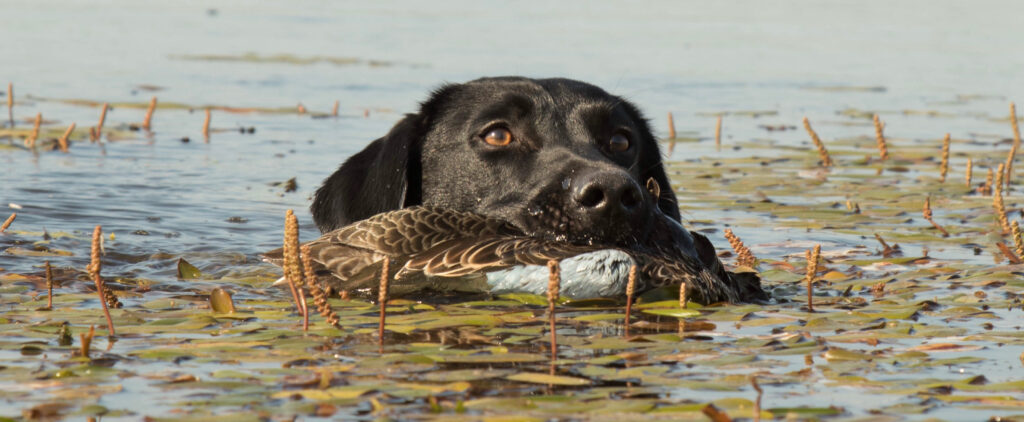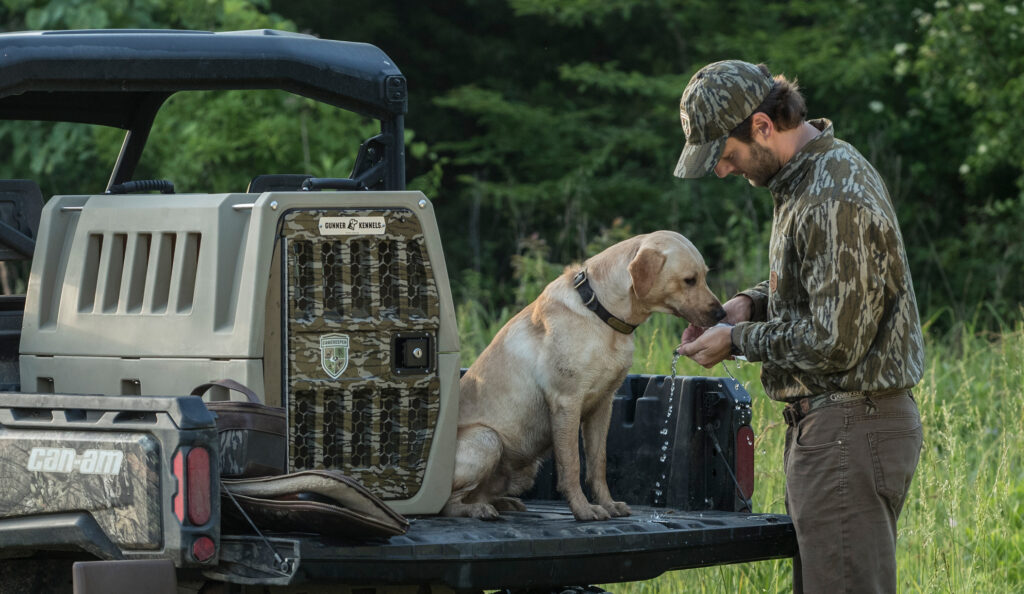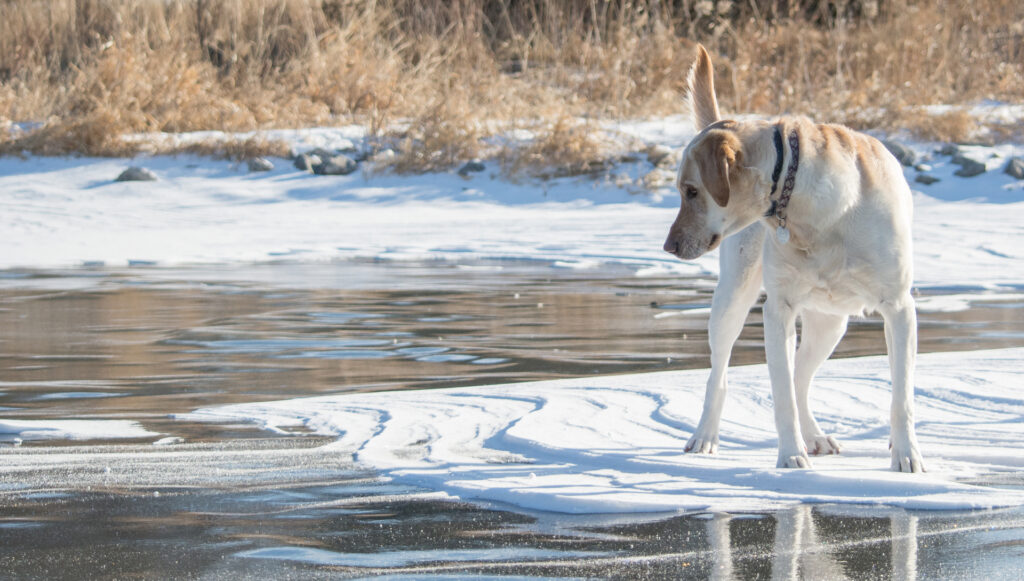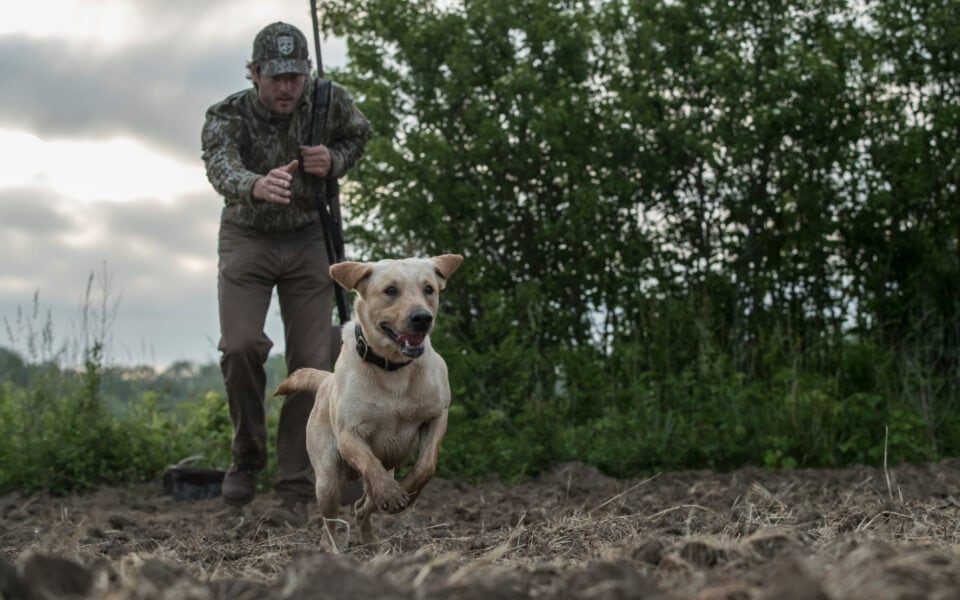Unfortunately, like with humans, there are health related issues that can arise from situations both in and around the house and in the field. With hunting season kicking off, we felt that it was a good time to make our hunters aware of two very real dangers to our pets and methods for preventing heat stress and hypothermia in hunting dogs.
Hyperthermia in Dogs
Summertime is sometimes problematic for dogs and hunters alike, when high temperatures combined with high humidity result in a heat index that is several degrees higher than the actual temperature. In the south, we normally experience some extremely hot-humid sunny days during the dog days of summer that extend into early dove season, the early fall teal season, and the early resident goose season. During these early seasons a dog can easily become overheated and if the situation is not properly dealt with, the end result can be the onset of hyperthermia, commonly known as a “heat stroke,” that can be debilitating for the remainder of the dog’s life or even result in death.

Hyperthermia by definition is having a temperature above normal. Normal in a lab is 100.5 to 102.5 degrees Fahrenheit. So, how do you know that your retriever is overheating? The primary source of heat exchange in a dog is panting, so if a dog is panting, he/she is beginning to overheat. But there are other indicators such as: dehydration, excessive drooling, curled tongue, red gums etc.
When training or hunting, I rely on an easy and surefire method for early detection of heat exhaustion and that is to keep a close watch on the tip of his tongue. When the tip starts to turn red and starts to curl, it is time to give the dog a long break and possibly quit for the day. Otherwise, you run the risk of allowing your “Best Friend for Life” to suffer the dire consequences of a heat stroke.
Dr. Karen Emerson, DVM, states that hyperthermia can be caused by lack of conditioning, lack of acclimazation and very high humidity and temperatures. She further noted that hunting dogs are very energetic and love the thrill of the hunt. They love to please their owners and get the gratification. It is the responsibility of the owner / trainer to make sure the dog is monitored and rested appropriately and hydrated. Only small amounts of water should be given throughout the hunt – do not allow the dog to drink excessively as this can lead to nausea and bloated stomach.
The clinical sign of hyperthermia is “panting to extreme hyperventilation” and hyper salivation and altered mentation – a glassy eyed look. They then experience a drunken-like stupor, some have vomiting and diarrhea. It is so important if these clinical signs are noted to slow the dog down, get the dog to a shaded area and start to cool the dog down with cool water spray and apply ice to the belly-this will help decrease their temperature.
You can also place the dog in an air conditioned vehicle to allow cool down. When the body has an extremely high temperature the internal tissue can be cooked causing the body to go into shock and then can lead to death.
It is very important to acclimate the dog to the environment for about 20 minutes-this is the same as an athlete warming up prior to a big game. Also, toward the end of the hunt allow the dog to cool down with low activity for about 10 minutes; this allows the animal to cool down and not just abruptly stop working.
Many hunters mistakenly believe that if their dog begins to overheat the best solution is to let him/her swim in a pond or lake to cool off. While this tactic is better than nothing, you aren’t going to gain much in terms of relief from elevated body temperature because the surface temperature of the water, down to the thermocline, is about the same as or higher than the ambient temperature of the air and the wet hair actually restricts the flow of air to cool the dog’s body.

Also, many believe that on extremely hot days it is safer to work a retriever in the water. Again, the temperature of the water is about the same as the ambient temperature of the air or higher and just as on land, the dog can easily overheat while retrieving in water.
So what can you do? From a prevention standpoint, don’t put your dog in a training or hunting situation that would expose them to a possible heat-stroke by limiting the number of his retrieves, keeping them in the shade out of direct sunlight, and keeping him well hydrated by keeping a good supply of cool water for him to drink.
Especially on dove hunts, always take a supply of water and a water bowl for your dog to drink out of. To keep your dog hydrated, give it an ample supply of water and then let him/her rest for a few minutes. Then resume retrieving and after a few more retrieves let him/her drink again. To avoid water intoxication, don’t keep water in the bowl at all times; instead, ration it out so that the dog intake is no more than its body can process.
Always be observant by keeping a watchful eye on your retriever looking for any signs of overheating and upon seeing the first sign of overheating (the tip of the tongue turning red and beginning to curl – STOP immediately and allow him to rest and cool off using the techniques set forth by Dr. Emerson.
Hypothermia in Dogs

Heather
At the opposite end of the spectrum, is another potential life threatening health risk – hypothermia. Hypothermia is defined as a low body temperature caused by several factors and can be classified as mild, moderate, or severe. A good example is a situation that I encountered at the end of the 2018/2019 waterfowl season.
At the end of the duck season, I was involved in the aftermath of the onset of a very serious situation involving a lab that was hypothermic. Upon arrival, my initial thought was that the Labrador was not going to survive, but the veterinarian we summoned provided immediate and excellent care and the dog is fine today.
When I first saw the lab, outside the vet office, he exhibited the classic symptoms of hypothermia. He was lethargic, his pupils were fixed and dilated, was shivering, drooling, and having difficulty breathing. While waiting on the vet to arrive, I was attempting to warm him and all of a sudden his body went rigid, his mouth locked in an open position, his eyes rolled back in his head, and his tongue pulled back in his throat.
He looked as though he had passed away or was going to in short order. I grabbed him, shook him until his muscles relaxed and then checked to see if he was breathing-I could not detect any breath. I checked to see if his airway was blocked, and it was not. I then put my mouth over his nose and performed what might be best described as rescue breathing. He responded and began breathing on his own and soon thereafter, his breathing became less labored.
After he began breathing, we laid him in the front floor board of the truck and put hunting coats over him, cranked the truck heater on high and placed the end of the coats over the lower heater vent so that the warm air would circulate around. I held him in this position until the vet arrived.
When the vet arrived, we carried him into the vet office and placed him on an examining table that was covered with a blanket. She immediately recognized the dog’s hypothermic / hypoglycemic condition, covered him up, placed heating pads on the covers, gave him an injection of steroids, and started a warmed IV. She then took his temperature and found that it was less than 82 degrees. Testing his blood revealed that his blood sugar (glucose) was extremely low, i.e., he was hypoglycemic. The vet gave him glucose thru his drip and the dog began to respond.
Discussing this situation with the labs owner revealed that his dog was wearing a vest, had retrieved twenty-one ducks and had been standing in a couple of inches of water for an extended period of time. He was feeding his dog a high grade dog food twice each day – morning and afternoon. He did not realize that his dog was hypothermic until it became lethargic. So what were the causative factors that lead to the onset of hypothermia and what steps could have been taken to prevent it? First let’s examine the warning signs.
Warning Signs of Hypothermia:
A dog’s normal body temperature is 100.5 to 102.5 degrees Fahrenheit. By definition, hypothermia is low body temperature caused by exposure to extreme cold for an extended period of time. The three levels of hypothermia are mild, moderate, and severe. Mild is associated with a body temperature of ninety (90) to ninety-nine (95) degrees Fahrenheit. Moderate is defined as a body temperature of eighty two (82) to ninety (90) degrees Fahrenheit. Severe is defined as a body temperature of less than eighty two (82) degrees Fahrenheit.
The symptoms vary with the level of hypothermia. Low level symptoms include weakness, shivering, and becoming lethargic. More advanced symptoms include muscle stiffness, lack of mental acuity, and shallow breathing.
 While there are many reasons for the onset of hypothermia, the principal reasons are the owner simply doesn’t know the causes and symptoms of hypothermia or the preventative measures that can be followed to greatly reduce the risk of the onset of hypothermia in a dog.
While there are many reasons for the onset of hypothermia, the principal reasons are the owner simply doesn’t know the causes and symptoms of hypothermia or the preventative measures that can be followed to greatly reduce the risk of the onset of hypothermia in a dog.
Contributing Factors: How many times have you heard of someone losing or almost losing their duck dog to hypothermia? What was the causative factor(s) leading to this condition? Could it have been the warning signs were ignored or simply a case of lack of awareness? It would probably be a combination of both.
In hot weather, dogs lose body temperature by panting and to some extent by sweating thru their paws, thereby cooling themselves down when their body temperature climbs. So it stands to reason that the reverse is also true, when a dog is standing in cold water he is losing body heat thru his paws exposure to the cold water. Couple this loss with the loss of body heat when swimming out to the blind and then back to the bank and exposure to the cold water on multiple retrieves during the hunt- the totality of heat-loss can reach severe limits in short order.
When this begins to happen, continued exposure to the cold can easily lead to the dog going into a downward spiral, that is, its muscles demand for energy increases and the elevated use of blood glucose to fuel its muscles quickly causes glucose levels to plummet to a critical level. As the dog’s glucose levels are drawn down to increase body heat, the dog continues to lose body heat from the cold, the glucose levels continue to drop and the dog begins to exhibit the signs of hypothermia or “hunting dog hypoglycemia” – a potentially fatal condition.
Dr. Emerson states that hypoglycemia or low blood sugar normally occurs during a hyperthermia and hypothermic situation. A dog’s normal blood glucose is 70-150mg/dl. During hypoglycemia the blood sugar can drop to 50 or below. The clinical signs of hypoglycemia are; altered mentation (acting drunk), trembling excessively and showing extreme weakness – this can lead to collapse or show seizure activity. It is very important to allow your dog to eat a small meal before the hunt to avoid this state.
Most times this occurs in younger hunting dogs that are extremely anxious and exerting a lot of energy. The small meal should consist of a high protein diet. The owner should keep Karo syrup, honey or fruit juices in case the dog experiences this episode. You just rub the honey or Karo syrup on the gums to bring the blood sugar back to normal. If the dog is collapsing a veterinarian needs to be seen, but put the karosyrup and/or honey on the gums on the way to the hospital.
Feeding Schedule: Working dogs like Labrador retrievers burn a lot of fuel in an average day of duck hunting. In fact, I have been told that a working Labrador consumes 80% more fuel (glucose) while hunting than it will during an average day at the kennel. Assuming this percentage is factual, it stands to reason that a working Labs food intake needs to be increased exponentially to provide the necessary fuel for a hard day of hunting-especially in cold weather.
At the kennel, with the onset of cold weather, we always increase the amount of food given to our labs and we feed our labs once a day-always in the evening. Why? Because by feeding in the evening our dogs have overnight to digest the food and gain the maximum nutritional value from the food-allowing them to build levels of glucose sufficient to power their muscles for the duration of a hunt in cold weather.
Other Preventive Measures: The loss of a dog’s body heat can also be slowed by:
- Putting a neoprene vest on your dog during the hunt to retain body heat.
- Never taking your dog duck hunting in a place where he/she cannot get completely out of the water.
- Never placing your dog at risk by allowing the dog to wade or swim a long distance to or from your blind and making too many retrieves over the course of the hunt.
- Never allowing your dog to sit or stand in cold water for an extended period of time.
One last point, leaving your dog sitting in, or standing in cold water (even an inch or two) not only escalates the onset of hypothermia but, it also exposes your dog to possible frostbite of the feet and toes, the tips of the ears, the end of the tail, and the scrotum. The point to remember in all of this is – don’t expose your “Hunter’s Best Friend for Life” to a situation that could bring on the onset of hypothermia or frostbite and when you observe the first sign “shivering,” it is time to take action. Get the dog out of the water and warmed up. Also, carry a pack of honey or a bottle of sugar water to give your dog to help restore his/her glucose levels. In extreme cases this may mean abandoning the hunt, carrying your dog to the truck and running the heater, but it must be done.






